Class 9 Science: Sample Question Paper- 8 (With Solutions) PDF Download
SECTION - A
Q .1. Look at the graphs (a) to (d) and then tell which of these can possibly represent one dimensional motion of a particle.
(a)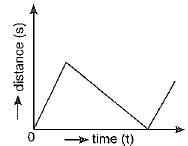
(b)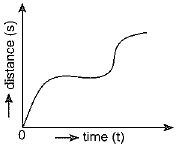
(c)
(d)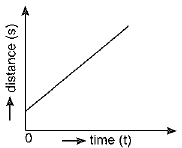
(a) graph (a) and graph (d)
(b) all four graphs
(c) graph (c) and graph (d)
(d) graph (d)
Ans: (d) Only graph (d) can represent one dimensional motion of a particle. All other curves are not possible because value of distance covered cannot decrease with increasing time.
Q.2. What type of mixtures are separated by the technique of crystallisation ?
Ans: Homogeneous mixtures of a pure solid in the form of its crystals from solution are separated by the technique of crystallisation.
Q.3. A mixture of sulphur and carbon disulphide is
(a) Heterogeneous and shows Tyndall effect
(b) Homogeneous and shows Tyndall effect
(c) Heterogeneous and does not show Tyndall effect
(d) Homogeneous and does not show Tyndall effect
Ans: (a) Heterogeneous and shows Tyndall effect
Explanation: A mixture of sulphur and carbon disulphide is a heterogeneous colloid and shows Tyndall effect. In a colloidal solution, the particles are big enough to scatter light. This phenomenon of scattering of light by colloidal particles is known as Tyndall effect.
Q.4. A girl is carrying a school bag of 3 kg mass on her back and moves 200 m on a levelled road. The work done against the gravitational force will be ig = 10 m s-2)
(a) 6 x 103J
(b) 6 J
(c) 0.6J
(d) zero
Ans: (d) Here weight of bag is acting in vertically downward direction and the displacement of the girl is in horizontal direction. As force and displacement are mutually perpendicular, hence the work done is zero.
Q.5. The numerical ratio of displacement to distance for a moving object is :
(a) always less than 1
(b) always equal to 1
(c) always more than 1
(d) equal or less than
Or
In the relation F = GMm/d2, the quantity G:
(a) depends on the value ofg at the place of observation
(b) is used only when the earth is one of the two masses
(c) is greatest at the suiface of the earth
(d) is universal constant of nature
Ans: (d) Or (d)
Q.6. Which cell does not have perforated cell wall ?
(a) Tracheid
(b) Companion cells
(c) Sieve tubes
(d) Vessels OR ,
Cartilage is not found in
(a) Nose
(b) Ear
(c) Kidney
(d) Larynx
Ans: (b) Companion cells Explanation: Companion cells possess numerous mitochondria and ribosomes and are supporting units of sieve tubes. They do not have perforated cell wall.
OR
(c) Kidney Explanation: Cartilage occurs at the joints of bones, in the nose, ear, trachea and larynx. It helps in smoothening the surface at the joints. It lends support and provides flexibility to the body parts.
Q.7. What is the atomicity of phosphorus ?
(a) 1
(6) 2
(c) 3
(d) 4
Ans: (d) 4
Atomicity is the number of atoms of an element present in one molecule of that element. The number of atoms present in a molecule of phosphorus are 4. So the atomicity of phosphorus is 4.
Q.8. The process of nitrogen-fixation by bacteria does not take place in the presence of:
(a) Molecular form of hydrogen
(b) Elemental form of oxygen
(c) Water
(d) Elemental form of nitrogen
Or
Which one is an oil-yielding plant among the following is :
(a) Lentil
(b) Cauliflower
(c) China rose
(d) Sunflower
Ans: (b) Or (d)
Q.9. Note is a sound
(a) of a mixture of several frequencies
(b) of a mixture of two frequencies only
(c) of a single frequency
(d) always unpleasant to listen
Ans: (a) of a mixture of several frequencies
Q.10. Vectors can be defined as
(а) diseased plants.
(b) infected person.
(c) microorganisms which cause many diseases.
(d) animals which carry the infecting agents from diseased person to healthy persons.
Ans: (d) Dog is a vector for rabies and female anopheles mosquito for malaria.
Q.11. Nervous tissue is not found in:
(a) Brain
(b) Spinal cord
(c) Tendons
(d) Nerves
Ans: (c)
Q.12. Arrange the following substances in the increasing order of force of attraction between their particles:
Oxygen, salt milk.
OR
A substance has no mass; can we consider it as matter ?
Ans: Oxygen < milk < salt
Or
No
Q.13. Action and reaction forces are equal and opposite but reaction acts a bit late after the action force.
Ans: False - Action and reaction forces always act simultaneously for exactly the same time.
Q.14. Assertion: If the speed of an object is made twice its kinetic energy becomes four times.
Reason : K.E. = 1/2 mv2
(i) A
(ii) B
(iii) C
(iv) D
Ans: (i)
SECTION - B
Q.15. A large truck and a car, both moving with a velocity of magnitude v, have a head-on collision and both of them come to a halt after that. If the collision lasts for 1 s :
(а) Which vehicle experiences the greater force of impact ?
(b) Which vehicle experiences the greater change in momentum ?
(c) Which vehicle experiences the greater acceleration ?
(d) Why is the car likely to suffer more damage than the truck ?
Ans: (a) During head on collision forces applied by truck and car are action-reaction forces. Hence, both vehicles experience same (equal) force of impact.
(b) Here initial velocity of both car and truck is same equal to v and final velocity of both is zero. But mass of truck is much more than that of car, hence change in momentum of truck is more than change in momentum of car.
(c) For same force of impact, the acceleration of car will have a greater magnitude  because its mass is less.
because its mass is less.
Q.16. (a) What is meant by a pure substance ?
(b) List the points of differences between homogeneous and heterogeneous mixtures.
Or
(a) Why copper sulphate solution in water does not show tyndall effect bu t mixture of water and milk shows ?
(b) When is a solution said to be saturated ? How can you change an unsaturated solution to a saturated solution without adding any more solute to it.
Ans: (a) A pure substance is a homogeneous material consisting of a single type of particles and definite set of properties.
(b)
Or
(a) The solute particles in copper sulphate solution are very small, i.e., of the order of 10-9 m and even smaller, thus they cannot scatter light and do not show tyndall effect. Whereas milk contains colloidal particles of fats and proteins which cannot be seen with naked eye but are big enough to scatter a beam of light and thus show tyndall effect.
(b) (i) When a solution cannot dissolve any more solute, it is a saturated solution at the given temperature.
(ii) By heating the unsaturated solution it can be converted into a saturated solution.
Q.17. Write answer in one word:
(i) The process by which the solid directly changes into gases without liquefying.
(ii) Energy required to change 1 kg of a liquid to gas at atmospheric pressure at its boiling point.
(iii) The property of gases which makes it possible to inflate a large number of balloons from a small cylinder of hydrogen gas.
OR
Give three reasons to justify that water is a liquid at room temperature.
Ans:(i) Sublimation,
(ii) Latent heat of vaporization,
(iii) Compressibility of hydrogen gas
OR
Fluidity, takes shape of th e container, fixed volume.
Q.18. Write the chemical formulae of the following :
(i) Magnesium phosphate
(ii) Zinc oxide
(iii) Ammonium sulphate
(iv) Aluminium hydroxide
(v) Sodium phosphate
(vi) Zinc bromide
Ans: (i) Magnesium phosphate or Mg3(PO4)2
or Mg3(PO4)2
(ii) Zinc oxide or Zn202 or ZnO
or Zn202 or ZnO
(iii) Ammonium sulphate or (NH4)2SO4
or (NH4)2SO4
(iv) Aluminium hydroxide or Al(OH)3
or Al(OH)3
(v) Sodium phosphate or Na3PO4
or Na3PO4
(vi) Zinc bromide or ZnBr2
or ZnBr2
Q.19. How many types of elements together make-up the xylem tissue ? Name them,
Ans: Four types of elements make-up the xylem tissue. These four elements are:
(i) Xylem tracheids [Tubular unicellular and, therefore, transport water and minerals vertically].
(ii) Xylem vessels |Multicellular].
(iii) Xylem parenchyma [Stores food and helps in the sideways conduction of water].
(iv) Xylem fibres [Provides mechanical support].
Q.20. (a) What is the relationship between two elements X and Y whose atomic numbers are 18 and 20 respectively, but their mass numbers remain same as 40 ?
(b) Which has more number of electrons : Na or Na+ ? Why ?
(c) Name the isotope used to treat:
(i) Goitre,
(ii) Cancer.
Ans: (a) Isobars. (X-Argon and Y-Calcium)
(b) Na contains one electron more than Na+.
The (+) ve charge indicates that it has lost one electron.
(c) (i) Isotope of iodine is used in the treatment of goitre.
(ii) Isotope of cobalt is used in the treatment of cancer.
Q.21. Compare the force of attraction between iron, rubber band and chalk.
Ans: Take an Iron nail, a rubber band and a piece of chalk. Try to break them by hammering or cutting. It is observed that it is most difficult to break an iron nail but the easiest to break a piece of chalk. This shows that force of attraction between the particles is maximum in an iron nail but minimum in case of a piece of chalk.
Q.22. Amit buys few grams of gold at the poles as per the instruction of one of his friends. He hands over the same when he meets him at the equator. Will the friend agree with the weight of gold bought? If not why? [Hint: The value of g is greater at the poles than at the equator.]
Ans: Weight of an object is equal to mg where m is mass of the object is less at the equator than a the poles as the value of g is less at the equator than at the poles.
So his friend will not agree with the weight of eold at the poles when measured at eauator.
Q.23. The velocity-time graph of an object is shown in the following figure :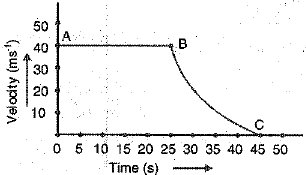
(i) State the kind of motion that the object has from A to B and from B to C.
(ii) Identify the part of graph where the object has zero acceleration. Give reason for your answer.
(iii) Identify the part of graph where the object has negative acceleration. Give reason for your answer.
Ans: (i) Uniform motion from A Lo B and non-uniform motion from B to C.
(ii) AB because velocity remains constant from A to B.
(iii) BC because velocity decreases from B to C.
Q.24. What do you know about hole in ozone layer ? Explain the probable damages caused by it,
Or
What factors are responsible for storage losses in agricultural produces and how they can be controlled and prevented ?
Ans: Ozone, O3 is a molecule that contains three atoms of oxygen. Ozone is poisonous but it is not stable near the Earth’s surface. It occurs in the zone of Earth’s atmosphere called stratosphere.
Ozone absorbs harmful ultraviolet radiations from the Sun. Thus it protects us from certain diseases like cancer.
Various man-made compounds like chlorofluorocarbons (CFCs) react with ozone molecule and cause depletion in the ozone layer in the atmosphere.
Recently a hole in the ozone layer has been discovered above the Antarctica. Due to ozone layer depletion, UV-rays can enter the Earth’s atmosphere and cause certain diseases.
OR
Ans: Following factors may be responsible for losses of grains during storage :
(i) Biotic factors: They include insects, rodents, bacteria, fungi and mites.
(ii) Abiotic factors: They include inappropriate moisture and temperature in the place of storage.
These factors cause poor quality, loss in weight, discolouration of produce, poor germinability and marketability of grains.
These factors can be controlled by proper treatment and by systematic management of warehousing.
Preventive measures include strict cleaning of produce before storage, proper drying of the produce first in sunlight and then in shade and fumigation using chemicals to kill pests.
SECTION - C
Q.25. (a) Draw velocity-time graph for an object that has initial velocity 'u’ and is moving with uniform acceleration 'a'
(b) Use the above graph to derive position-time relation s = ut + 1/2 at2.
(c) Shatabdi Express starting from rest attains a velocity of 108 km h-1 in 2 minutes. Assuming the acceleration to be uniform, find the value of (i) acceleration, (ii) the distance travelled by the train for attaining this velocity.
or
The distance-time graphs of two trains A and B are given. The trains start simultaneously in the same direction.
(а) How much ahead of A is B when the motion starts ?
(b) What is the speed of B ?
(c) When and where will A catch B ?
(d) What is the difference between the speeds of A and B ?
(e) Is the speed of both the trains uniform or non-uniform ? Justify your answer.
Ans: (a) Velocity-cime graph, for an object having initial velocity 'u' and uniform acceleration ‘a’ has been drawn below.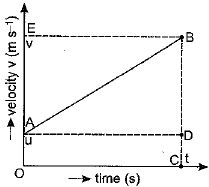
(b) According to velocity-time graph the total distance covered by the object is by the area under the graph.
Hence, distance s travelled by the object = area of the trapezium OABC
= area of rectangle OADC + area of triangle ADB
But OA = u, OC = t, AD = OC = t and BD = change in velocity = v - u = at
∴ 
(c) Here initial velocity u = 0 , time t = 2 minutes = 120 s,
and final velocitv v = 108 km h-1 =  = 30 m s-1
= 30 m s-1
(i) Acceleration o f the train a = 
(ii) If the total distance travelled by the train for attaining the velocity v be s, then
2as = v2 - u2
or 
Or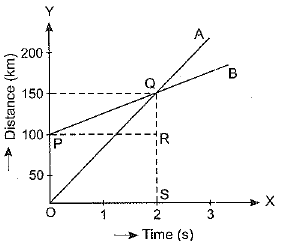
(a) The train B is 100 km ahead o f A when motion starts (i.e., at t - 0).
(b) Uniform speed of B: vB = =25 km h-1
=25 km h-1
(c) A will catch B at time t = 2 s at a distance s = 150 km from the reference point. It is shown as point Q on the graph.
(d) Uniform speed of A: 
∴ difference vA - vB = 75 - 25 = 50 km h-1
(e) Speed o f both the trains is uniform because s-t graphs for both are straight lines inclined to the axes.
Q.26. Calculate the formula unit masses of ZnO , Na2O , K2CO3 given atom ic masses o f Z n = 65 u, Na = 23 u, K = 39 u, C = 12 u , and 0 = 16u .
(b) Which has more number o f atoms, 100 gram s o f sodium or 100 gram s o f iron (given,,atomic mass o f Na = 23 u, Pe = 56 u) ?
Ans: (a) Formula unit mass of ZnO = 1 x atomic mass of Zn + 1 x atomic mass of O
= 1 x 65 u + 1 x 16 u = 81 u
Formula unit mass of Na2O = 2 x atomic mass of Na +1 x atomic mass of O
= 2 x 23 u + 1 x 16 u = 62 u
Formula unit mass of K2CO3 = 2 x atomic mass of K + 1 x atomic mass of C + 3 x atomic mass of O
= 2 x 39 u + 1 x 12 w + 3 x 16 u
= 78 u + 12 u + 48 u = 138 u
(b) (i) 23 g of sodium has atoms = N (Avogadro's number)
∴ 100 g of sodium has atoms = 
(ii) 56 g of iron has atoms = No[Avogadro's number]
∴ 100 g of iron has atom 
100 g of sodium has more atoms than 100 g of iron.
Q.27. (i) How is gaseous nitrogen fixed by the plants?
(ii) Schematically depict nitrogen cvele in nature.
(iii) Mention any one difference between nitrogen fixation and nitrification.
Ans: (i) The gaseous nitrogen is fixed by the process of 'nitrogen fixation'.
There are nitrogen-fixing' bacteria may be free-living or be associated with some species of dicot plants .Generally the nitrogen-fixing bacteria are found in the roots of legumes in special structures called root nodules. These bacteria convert the nitrogen molecule to nitrates and nitrites. Plants take up nitrates and nitrites and convert them into amino adds which are used to make proteins.
(ii) Nitrogen Cycle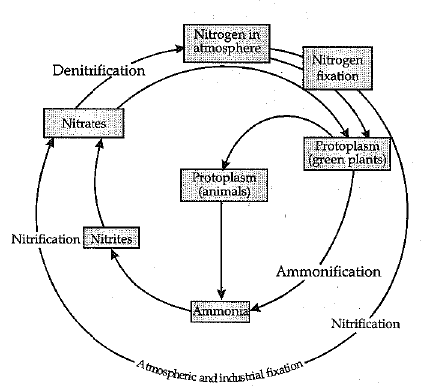
(iii) Nitrification is conversion of ammonia to nitrites/nitrates. Nitrogen fixation is conversion of atmospheric nitrogen to compounds of nitrogen.
Q.28. (a) What underlying principle of prevention makes you follow the practice “Prevention is better than cure” in any disease ?
(b) Which specific method of prevention would you adopt for a disease like tuberculosis. Explain how does this method help in preventing the disease.
Or
(а) State one difference between :
(i) tendon and ligament
(ii) apical meristem and lateral meristem.
(b) Name the longest cell of human body. Depict its structure with the well labelled diagram only.
Ans: (a) “Prevention is always better than cure” because every infection brings about misery not only to the affected person but also a number of others connected to the same in following ways :
(i) Damage occurs to one or the other body functions.
(ii) Treatment of infectious disease and complete recovery afterwards would keep the patient bed ridden for a few days.
(iii) A person suffering from infectious disease serve as a source of infection which can spread to others.
(b) Disease like tuberculosis can be prevented by vaccination.
Vaccines are heat killed or chemically weakened germs which when injected in our body develops memory for a particular infection in our body. It stimulates the formation of antibodies by the immune system which prevent any subsequent exposure to the infecting microbe from turning into an actual disease.
or
(a) (i)
(ii)
(b) Longest cell in human body is Neuron.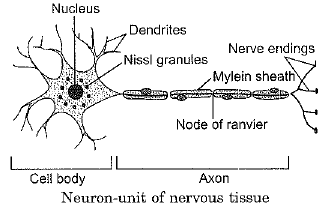
Q.29. (a). State which of the following situations arepossible and given an example for each of these:
(i) An object with a constant acceleration but with zero velocity.
(ii) An object moving in a certain direction with acceleration in the perpendicular direction.
(b) An artificial satellite is moving in a circular orbit of radius 42250 km. Calculate its speed if it takes 24 hours to revolve around the earth.
Ans: (a)(i) A body with a constant acceleration but with zero velocity is possible. For example, when a body is iust released, its initial velocity u = 0, but acceleration a. v = 10 ms-2.
(ii) When a stone, tied to a string, is whirled in a circular path, the acceleration acting on it is always at right angles to the direction of motion of stone.
(b) Distance covered by the satellite in 24 hours
Therefore, speed of the satellite is
Q.30. What is meant by 'inertia' ? What are different types of inertia ? Give two examples in each case.
Ans: Inability of the bodv to change by itself its state of rest or state of uniform motion is called inertia.
Types: Inertia;of rest : e.g.:
(i) When a card is flicked with a finger the coin placed over it falls in the tumbler.
(ii) Only the carom coin at the bottom of a pile is removed when a fast moving carom striker hits it.
Inertia of motion: e.g. :
(i) When a moving bus stops suddenly, the luggage might slide towards the front side of the bus and fall.
(ii) We tend to fall forward when a bus suddenly stops.
FAQs on Class 9 Science: Sample Question Paper- 8 (With Solutions)
| 1. How can I access Class 9 Science Sample Question Paper-8 with Solutions? |  |
| 2. What is the purpose of Class 9 Science Sample Question Paper-8? |  |
| 3. How can I use Class 9 Science Sample Question Paper-8 to prepare for my exam? |  |
| 4. Are the solutions provided in Class 9 Science Sample Question Paper-8 accurate and reliable? |  |
| 5. Can Class 9 Science Sample Question Paper-8 help in scoring better marks in the exam? |  |














